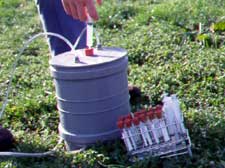Environmental impact of fertilisers on agriculture

The problem is intensive agriculture. Nowadays, some farmers have too many heads of cattle in comparison with their land under tillage. Due to this, purines (manure and stable/barn droppings) are applied in high concentrations on these soils, above all on those around the barns. Also, in order to feed the land which is further afield, farmers buy mineral feeds. Great problems for the environment arise out of the application of high quantities of mineral fertilisers and purines.
The Department of Vegetable Biology and Ecology have been studying this problem for 12 years now. The aim of the researchers is to measure the efficacy of fertilisers used in agriculture and to know their effect on the environment.
The importance of nitrogen
Nitrogen is the principal component in the majority of fertilisers used in agriculture. This is due to the property of this element of accelerating production and vegetable growth. But if it is applied excessively to the soil, plants are unable to absorb all the nitrogen and problems will arise. On the one hand gas emissions are produced and, on the other, water is contaminated.
Gas emissions are produced due to the activity of certain micro-organisms present in the land. Some of these gas emissions, for example nitrous oxide (N2O) and nitric oxide (NO2), can create serious environmental problems. The first is known to cause the greenhouse effect and, together with CO2, is an extremely dangerous compound and nitric oxide can produce acid rain.
Apart from gas emissions, water contamination has to be taken into account. When nitrogen appears in nitrate (NO3) form, it can enter rivers, lakes, and drinking water with the rain, giving rise to health problems in the case of drinking water. Moreover, in the case of contamination of rivers and lakes, it aids the eutrophisation of the water. Due to this eutrophisation, the growth of micro-organisms and aquatic plants is excessive and, consuming all the available oxygen in the water, fish life dies.
The research
Taking these problems into account, the researchers carried out a comparative study of purines and mineral fertilisers. It was clear from the results that the purines performed more slowly than the fertilisers, but that both are equally contaminant as regards gas emissions and ability to pollute water. Thus, it cannot be said that one is “better” than the other.
A second stage involved the analysis of the soil characteristics. A comparison between grazing pastures and fields under cultivation. From this study, it was clear that grazing pastures are more prone to gas emissions and, on the other hand, on cultivated land nitrate is more likely to reach and contaminate water.
Finally, the researchers are analysing the inhibitors of the micro-organisms which produce nitrates, nitrous oxide and nitric oxide. This is in order to have lower gas emissions and less nitrate in water. They are currently analysing the inhibitors to see if they also influence vegetable growth, measuring their capacity as inhibitors, and observing any change in crop production and measuring gas emissions.
There is still considerable research to be carried out.
Contact :
Garazi Andonegi
Elhuyar Fundazioa
garazi@elhuyar.com
(+34) 943363040
Media Contact
More Information:
http://www.ehu.esAll latest news from the category: Agricultural and Forestry Science
Newest articles

Properties of new materials for microchips
… can now be measured well. Reseachers of Delft University of Technology demonstrated measuring performance properties of ultrathin silicon membranes. Making ever smaller and more powerful chips requires new ultrathin…

Floating solar’s potential
… to support sustainable development by addressing climate, water, and energy goals holistically. A new study published this week in Nature Energy raises the potential for floating solar photovoltaics (FPV)…

Skyrmions move at record speeds
… a step towards the computing of the future. An international research team led by scientists from the CNRS1 has discovered that the magnetic nanobubbles2 known as skyrmions can be…





















